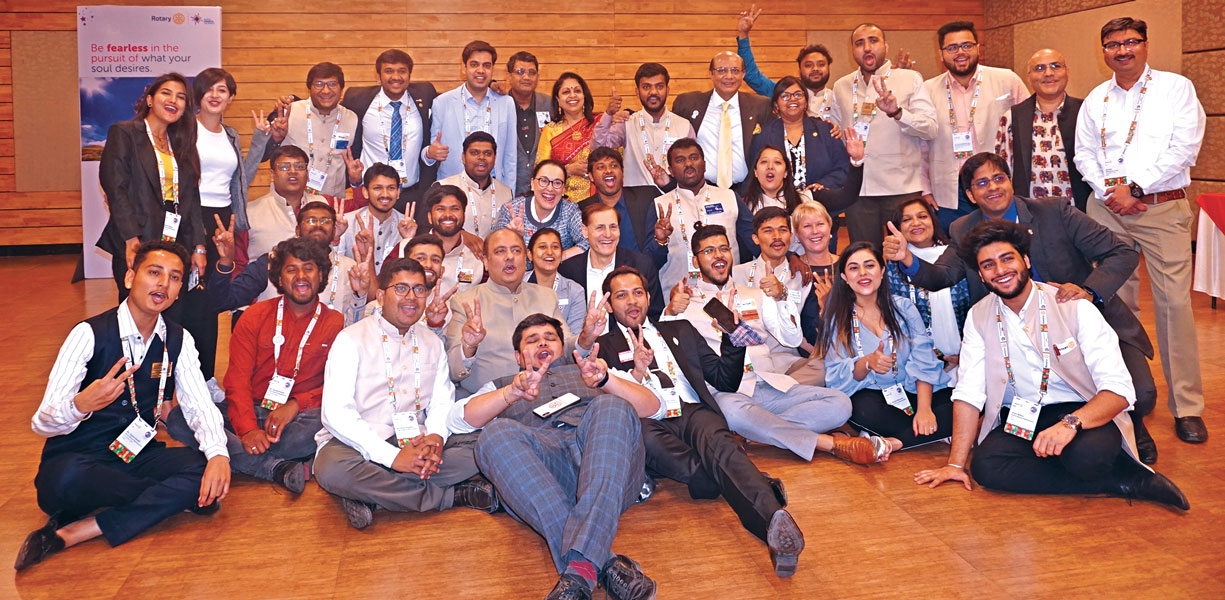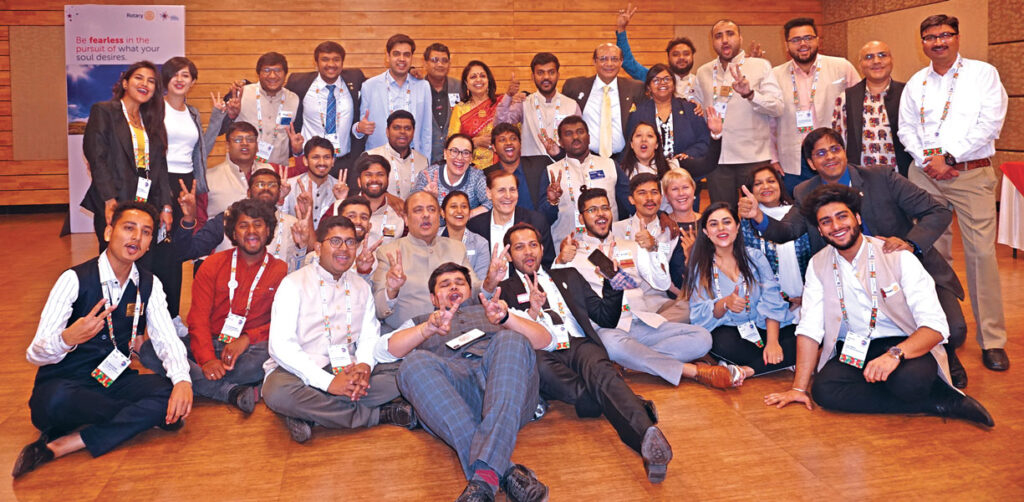
The increasing importance of Rotaractors — from the resounding success of the #Elevate Rotaract vote at the last CoL, invitation of 60 Rotaractors at the International Assembly 2019 in San Diego, to their huge participation in the Hamburg Convention — was reiterated at the Indore Institute. In a first-of-its-kind, 26 Rotaractors were brought to Indore to participate in the proceedings, with an exclusive session for them, which saw diverse views on the recent Board decisions pertaining to Rotaract.
At a panel discussion, it was disclosed that the RI Board has decided to collect per capita dues from Rotaractors. To a query from Srijitha, PDRR of RID 3291, on the amount, RI President Mark Maloney said that it will be decided at the upcoming Board meeting. “It will be a reasonable rate. Definitely not as much as what Rotarians pay. It will streamline our administration. At present we really do not know how many Rotaractors we have. When we have dues paying members we will have statistical information that we can plan with and build upon. Further, with Rotaract as member of RI, clubs will be expected to do some service and we need funds for that.”
In 2016, we found that only five per cent of Rotaractors transitioned into Rotarians. That shocked us.
— Jennifer Jones TRF Trustee
He said this at a panel discussion with TRF Trustee Jennifer Jones, RI General Secretary John Hewko, DRR Kushal Bhuva from RID 3054 and PDRR Srijitha of RID 3291, moderated by RID Kamal Sanghvi. Maloney, RIPN Shekhar Mehta, RID Bharat Pandya, TRF Trustee Gulam Vahanvaty and PRID C Basker were among the audience comprising Rotarians and Rotaractors.
#Elevate Rotaract, lifting the age limit of Rotaractors and doing away with Rotary sponsoring Rotaract clubs were all discussed.
“Why was it necessary to elevate Rotaract?” asked Sanghvi to Jennifer. She replied: “In 2016, we found that only five per cent of Rotaractors transitioned into Rotarians. That shocked us. We thought that Rotary was part of their DNA and we should keep them as part of the family. The decision on dual membership at the 2016 CoL brought the Rotarians and Rotaractors one step closer. Many Rotaractors did become dual members. Then in 2019, we elevated Rotaract and made it a member of RI — a very important step to tell Rotaractors that you are more than just members, you are part of the Rotary family.”
The vote for Elevate Rotaract at the 2019 Council didn’t pass the first time. “There was a humongous campaign which started within seconds on social media, so much so, there was a repeat vote the next morning, and it was approved with a huge majority. What a celebration that was,” she said.
“The decision has given us more responsibility so that we can execute bigger things now,” commented DRR Bhuva and PDRR Srijitha said, “A number of my fellow Rotaractors have promised to join Rotary now.” She is a dual member since 2017 and will be chartering a Rotary club by the end of this month.
Following recommendations from the Elevate Rotaract Task Force, the RI Board which met in October, has removed the upper age limit of Rotaract while maintaining that Rotaract is a programme for young adults. Commenting on this decision, Hewko said that when the upper age for Rotaract was 30, and 40 was the threshold for joining Rotary, it was a big gap. People who had left Rotaract could engage with Rotary only after 10 years. By then they were lost. “We found we were losing 95 per cent Rotaractors. Hence, this decision to allow Rotaractors to continue in Rotaract until such time they are ready to join Rotary.”
To the DGEs and DGNs, he said, “Utilise this opportunity to strengthen membership. Treat Rotaractors as equals. That means, giving them positions wherever appropriate — to run sessions in a district conference, projects and to really make a difference. They are just not guards to do the heavy weightlifting. They can provide tremendous ideas, energy for leadership in terms of how we can move Rotary forward in India, and throughout the world.”
“Srijitha, would you still like to open a Rotary club or would you like to stay as a Rotaractor,” asked Sanghvi.
“When I joined Rotaract it was more of fellowship, professional development and leadership. Now we are moving towards a Rotaract that is equally emphasising on service. I think one should listen to his/her inner call. You may be 30 or beyond. But you will know that it is time to move on to the next level. I felt this transition being a dual member. Some of you could feel to continue as a Rotaractor and certainly at some point you will get a call. It opens out boundaries and gives us opportunities to serve,” replied Srijitha.
The Board has removed the age limit for Rotaractors, but it doesn’t stop any club from having an age limit.
— Shekhar Mehta, RI President-nominee
Surprisingly, the decision lifting the cap on age limit did not go well with a majority of Rotaractors or Rotarians. “It need not be 30, and can go up to 35. But age limit has to be defined. Because Rotaract is such a fun movement that nobody would want to leave. Ultimately I strongly recommend every Rotaractor to join Rotary as and when they become financially comfortable,” commented PDRR Shashwat Desai, son of PDG Ashish Desai and DG Bina of RID 3060.
Rtn Harshvardhan, a past DRR 15 years ago and a second gen Rotarian, said, “The essence of Rotaract is in its youth. By extending the age, you are removing the essence of the youth. Taking it beyond 30 will boomerang for Rotary.”
RIPN Mehta, sharing his views on the decisions, said, “The DGs, DGEs and DGNs have agreed to include their DRRs as members in their Membership Committees. The Board has removed the age limit for Rotaractors, but it doesn’t stop any club from having an age limit. If a Rotaract club wants to fix an age limit as 35 or 40, you can still do that. I think we have best of both the worlds.”
Jennifer observed how much Rotarians and Rotaractors can learn from each other and she saw this first-hand at the last IA at a breakout session on public image. “When a DGE said that Rotaractors can help with the social media, a Rotaractor from India quickly responded: yes, we can help you with technology and social media. But we want you to teach us how to tell a story. The moment was so brilliant… this idea of cross-mentorship between Rotarians and Rotaractors.”
Another Board decision highlighted by Rtn Karthik Kittu, a past member of RI’s Rotaract-Interact Committee, was that if five Rotaractors pool in and contribute $50 to TRF, they will get a certificate directly signed by the TRF Chair. “This is a remarkable decision. Earlier you would get certificates only on contributing $1,000,” he said.
There was a mixed response to the decision allowing Rotaract clubs to be chartered without a sponsoring Rotary club. Srijitha felt that institution-based clubs do not require a sponsor, but community-based clubs need one.
But Bhuva opined that doing away with the sponsor was not a great idea. “We are a group of young people who may want to become president by chartering a new club. Then the club’s sustainability will go down. Further if a Rotary club is sponsoring a Rotaract club, then Rotary will hand-hold them in the initial stage at least,” he added.
Earlier RIPN Mehta, RIDs Pandya, Sanghvi and Hewko addressed the Rotaractors in a brief session. “Rotaract is growing in our country. But you must take your positions seriously and focus on membership,” said Pandya, adding that in many clubs, it is only on paper and the process needs to be streamlined for better benefits.
Pictures by Jaishree







